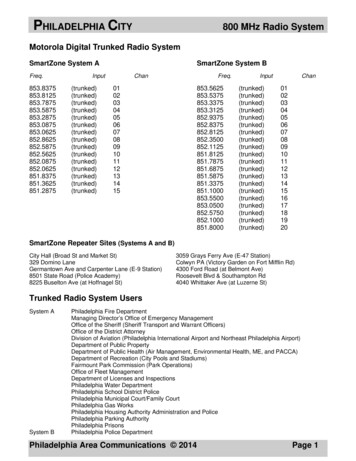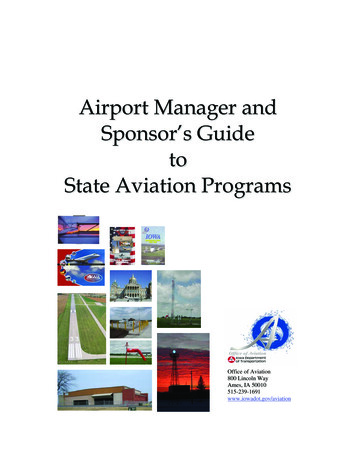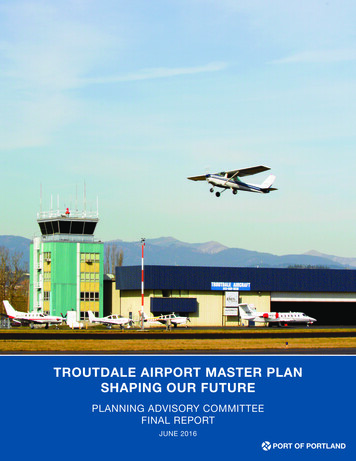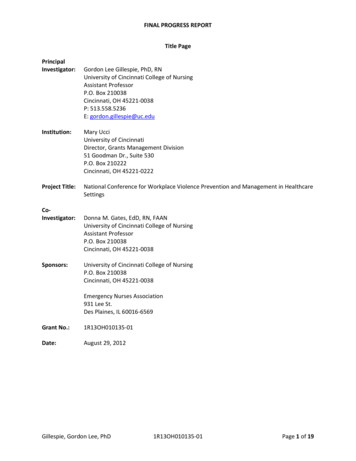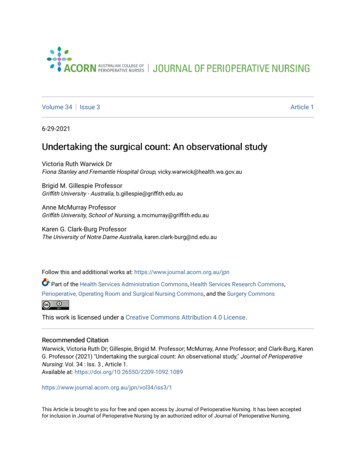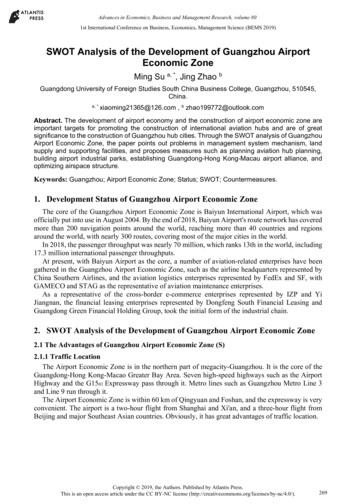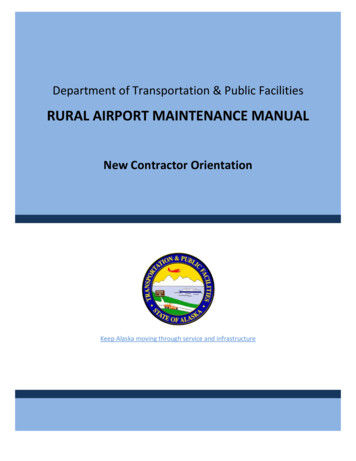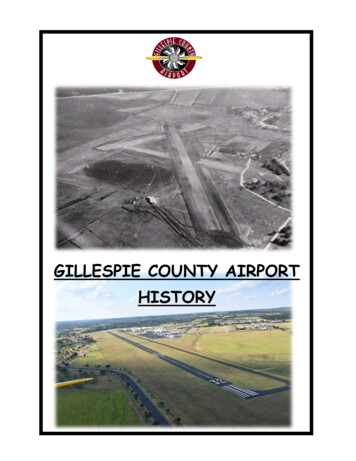
Transcription
GILLESPIE COUNTY AIRPORTHISTORY
T82 History (2021)PrefaceThis is the written history of Gillespie County Airport. It waswritten by Tony Lombardi and edited by Beverly Smith. All theinformation in this document is from official documents, publicinformation, or personal interviews.1
T82 History (2021)GILLESPIE COUNTY AIRPORT (T82) HISTORYIntroductionGillespie County Airport is a small general aviation airport located 2.5 miles south ofdowntown Fredericksburg, Texas. The FAA airport designator for Gillespie County Airport isT82 (Tango 82). Even though the airport resides within the city of Fredericksburg, the owner andsponsor of the airport is Gillespie County. Since Fredericksburg is a very popular touristdestination, the airport serves as the gateway to the town from the air. The airport’s terminalramp is full almost every weekend with tourists visiting the town, but it was not always thispopular.Pre-WWIIThe Hill Country has a rich history of aviation. One aspect of this history is verycontroversial. Jacob Brodbeck, a teacher, a surveyor, and a County Commissioner in theFredericksburg, Texas, area, is believed to be the first human to fly an aircraft under poweredflight. This is said to have occurred 40 years before the Wright brothers made their historic flightat Kitty Hawk. There are conflicting reports of the location of Brodbeck’s flight. It is said tohave occurred either three miles east of Luckenbach, Texas, in 1865, or in San Pedro Park in SanAntonio, Texas, in 1868. A bronze bust depicting Jacob Brodbeck, with an explanatory plaque,stands proudly in Fredericksburg's Marktplatz Park.Photo: Jacob Brodbeck’s statue and the crash site from his only flightAs aviation matured, the military started utilizing the airplane more and more. Airfieldsstarted popping up throughout Texas. Randolph Field in San Antonio became one of the2
T82 History (2021)military’s main training airfields. Additionally, the military used San Angelo’s and Brady’sairfields to support their training operations. The military would often fly between the threeairfields, which would take them over the Fredericksburg area during their route of flight.During the early 1940’s, after multiple emergency or crash landings in the Fredericksburg area,Norman Dietel, the owner and publisher of the Fredericksburg Radio Post, which was the secondnewspaper in Fredericksburg (from 1922 until 1984), tried to petition the US Military to build anairport in the Fredericksburg area. Even though the idea was supported by some of the seniormilitary officers in the area, nothing ever materialized.One of the response letters to Norman Dietel (From the Gillespie County Historical Society)During this same period, a parallel effort to build an airport in the Fredericksburg areawas just beginning. This effort was led by H.C. “Hans” Hannemann and his friend, businessassociate, and mentor, William “Red” Schroeder. Hannemann and Schroeder were local pilotswho were assisting the Navy with the training of their pilots at Schreiner Field in Kerrville. Thetwo men took turns driving back and forth to Kerrville to conduct flight training.3
T82 History (2021)Photo: Hans Hannemann in front of the Navy training aircraft (Stearman)Once the Navy had enough instructor pilots to conduct their own training, Hans and Redreturned to their local business in Fredericksburg and turned their attention to the creation of anairport in Fredericksburg. As one of the local area’s aviation experts, Hans tried to convince theGillespie County Commissioners of the need for an airport near Fredericksburg. Hans had foundthe perfect location for the airport about 2.5 miles south of town center, near Live Oak Creek.The County Commissioners were persuaded and decided to hold a bond election. The countybond election was for 95,000 and 360 acres. As the election approached, Hans attendednumerous town hall meetings throughout the county to convince local voters of the importanceof an airport near Fredericksburg. While Hans worked on voters throughout the county, Redcontacted local area business owners. On March 6th, 1945, thirteen hundred county residentsvoted. The bond issue passed by the slim margin of 19 votes. After obtaining the voters’approval, the county hired Engerle-Nixon to design the airfield. Using the Army Corps ofEngineers template, Engerle-Nixon created their plan for the airport. It included three crossingrunways. That original plan is posted on the wall of the Gillespie County Airport TerminalBuilding.4
T82 History (2021)Original drawing of the plan for Gillespie County AirportBetween 1945 and 1947, the county acquired the land for the airport. The land, totaling351.07 acres, was purchased from the Tatsch, Ahrens and Grobe families. After constructionbegan in 1947, it was determined that, due to land limitations, only one runway would be 3,000feet long. It would be the only paved runway. Construction was completed in 1948. A few yearslater, the county decided to close the two unpaved runways, thus making T82 a single-runwayairport.Photo: During Construction5
T82 History (2021)Photo: Construction Completed -1948The Need for LightsAfter the airport opened in 1948, it was designated for “daylight use only” because therunway was not equipped with runway lights or an aerodrome beacon. According to local lore, ifanyone wanted to land at night, Hans would gather the local farmers around the runway and usethe headlights from their vehicles to light up the runway and allow the landing.In 1954, the famous radio and TV broadcaster, Arthur Godfrey, wanted to visit his verygood friend, Senator Lyndon Johnson, at Johnson’s home near Stonewall, Texas. Mr. Godfreywas an accomplished pilot and aircraft owner and wanted to fly his aircraft to Texas for the visit.Due to circumstances out of his control, Godfrey was unable to arrive during daylight hours. Tomake matters worse, it was a dark stormy night. Luckily for Mr. Godfrey, a local farmer heardhis airplane circling around the airport and contacted Hans. Since it was a Sunday night, Hanswas able to gather enough local farmers (including a young Keith Keller) to light up the airfieldto allow Mr. Godfrey to land. Shortly after that event, Godfrey donated the money to installlights at the airport. Even though Arthur Godfrey was unable to attend the ceremony, SenatorJohnson presented the gift to Mayor Schroeder and County Judge Sagebiel on November 28th,1955. The gifted lights remained operational until they were replaced by LED lights in 2012.That addition made Gillespie County the first general aviation airport in Texas to have LEDrunway lights.6
T82 History (2021)Newspaper Article Photo: County Judge Sagebiel, Senator Johnson and Mayor Red Schroederinspecting the new lights for the airportIn anticipation of the installation of the donated runway lights, Hans Hannemann stillneeded to acquire a beacon light for the airport. During this time, airplanes would navigate atnight via a network of beacon lights. Pilots would see the flashing light and fly toward it. Oncethey reached the beacon light, they would observe and follow the large arrow on the ground tonavigate to the next beacon light. This would help them reach their destination.Example of a navigational tower and beacon light7
T82 History (2021)In 1954, the Civil Aeronautics Administration (the predecessor to the FAA), whichmanaged and operated the network of navigational beacon lights, decided to replace the SanMarcos beacon light with a new one to be located in New Braunfels, Texas. Hans Hannemannacquired the obsolete light and moved it to the Gillespie County Airport. The CAA providedHans with a conversion kit to make it an aerodrome beacon light. The refurbished light went intoservice in 1955 and remained the aerodrome beacon light until it was replaced in 2002.According to the airport manager at the time, the old beacon light was retired because it wouldhave been cost prohibitive to refurbish it again and bring it up to the standards of the time.Photo: The retired beacon light located at the Gillespie County Terminal buildingChanges to the Airport Over TimeShortly after the installation of the runway lights, the county decided to better utilize theland west of the runway. The terrain in this area made it unusable for the airport. The countycreated Oak Crest Park in 1957 and donated it to the City of Fredericksburg in 1967. Two yearslater, the city renamed the park Lady Bird Johnson Municipal Park.From the late 1950s until the late 1970s, there was very little aviation activity at theairport. It was mainly used by visiting hunters during hunting season. According to Keith Keller,a longtime supporter of the airport, during the early years, local youths often used the runway fordrag races. The first real development happened in 1976. The county and Triple K Aero, acompany owned by the Keller family, built the first two aircraft storage hangars on the field.The county built a 4-unit T-hangar and Triple K Aero built a 6-unit T-hangar. Two years later,8
T82 History (2021)the runway was extended to 3,800 feet. The runway extension project was funded by the federalgovernment.In the 1980s, Triple K Aero added its second aircraft storage hangar (a 10-unit T-hangar),and two other business hangars popped up. The runway length was unchanged until the 1990s.In 1992, having acquired land from the city, from the Eckhardt family, and from the Priessestate, the county, once again, extended the runway. The county added 800 feet to the existingrunway making it 4,600 feet long. In the mid-1990s, David Smith and his wife, Beverly, movedto the area. With support from the county, the Smiths built the fourth aircraft storage hangar onthe field. The county provided all the ground and pavement work for the project. Prior to Mr.Smith’s project, the airport’s consulting engineering firm (McCrary and Associates) hadrecommended that the county create a business park to better utilize some of the land on theairport. So, after approximately four years of coordination with TXDOT and the FAA, thecounty decided to convert approximately 25 acres on the northeast side of the airport into theAirport Business Park. In 1999, the FAA officially notified the county that it was approved todevelop the business park. The FAA designated its use as non-aeronautical. The business parkcannot access the operational/aviation side of the airport. Even though the business park is fornon-aeronautical use, it still belongs to the airport. All revenue from the business park goes tothe airport general fund.9
T82 History (2021)In the 2000s, the airport saw its biggest growth. As the new century started, the Estensonfamily began investing into the airport. They built the Hangar Hotel and the Airport Diner &Conference Center, which are the main tourist venues at the airport. While the Estensons werebeginning their projects, the airport underwent a major capital improvement project. The countyonce again extended the runway, this time to 5,001 feet, which is its current length at the time ofthis writing in 2020. This extension allowed larger jets to land at the airport. The county alsobuilt the full-length parallel taxiway, and the main terminal aircraft parking apron. The finalcounty project was the addition of a 3000-square-foot terminal building, located near mid-field,and a large, mid-field, aircraft parking apron. The terminal building is designed in the local“Fredericksburg style.” The county also changed the entrance to the airport from Tivydale Roadto the newly constructed Fair Drive. During this time, other major investors began building atthe airport. Bob and Karen Snowden built three of their four aircraft storage hangars between2002 and 2007. In the mid-2000s, David and Beverly Smith transferred their aircraft storagebusiness to another investor and opened Fredericksburg FBO (Fixed Based Operator) near theairport terminal building. The decade ended with a land swap between the City ofFredericksburg and Gillespie County. The city created a dog park on part of the land it acquiredin this transfer.10
T82 History (2021)The next decade saw continuous growth. Multiple new hangers were built, severalbusinesses were expanded, and several capital improvement projects were completed. With thehard work of Commissioner Donnie Schuch and of Paul Hannemann, the airport partnered withthe Texas Forest Service, a department of the Texas A&M University system. With thispartnership, the airport has become the central hub for the aviation firefighting capability forcentral Texas. The county donated five acres of land in the business park to allow a permanentoffice and equipment storage structure to be built. In addition, the county built a large aircraftapron near the donated land to assist with the firefighting operations. The 2010s ended with a 10acre land purchase from the city.11
T82 History (2021)Airport ManningWhen the airport opened in 1948, the County Commissioners allowed Bill Podall, whoserved as airport manager, to live on the airport. Hans Hannemann still assisted when needed.Through the years, Ray Tschirhart, Chad Doyle and Larry Nevels each served as part-timeairport manager. In 1995, Greg Snelgrove, a retired Army aviator, replaced Larry Nevels aspart-time airport manager. On November 1st, 2000, the County Commissioners made the airportmanager’s position a full-time job. Snelgrove’s office was in the County Courthouse until theterminal building was finished in 2002. The terminal building, designed by David Smith, housesthe airport manager’s office. It also has public restrooms, a lobby, and a conference/break room.In August, 2005, the county appointed Snelgrove to head the Economic DevelopmentCommission and hired Roger Hansen, a retired Air Force pilot, as airport manager. Hansenoversaw the continued growth of the airport until he retired in 2017. Tony Lombardi became thethird fulltime airport manager in March, 2017. Lombardi is another retired Air Force pilot.The Creation of the Airport Advisory BoardDuring the early 1990s, Keith Keller, a local pilot, business owner, and part-owner of twoaircraft storage hangars at the airport, realized that the part-time Airport Manager and the CountyCommissioners needed help managing the airport. Other airports in the area had advisory boardsthat could help the sponsor and the airport manager operate the airport. To create such a board in12
T82 History (2021)Gillespie County, Keith Keller coordinated with Commissioners William A. Roeder and EldonRay Feller to gain support. On November 1st, 1993, the Gillespie County Commissioners Courtcreated the Gillespie County Airport Advisory Board. The Board is made up of seven membersfrom the community, each appointed by the Commissioners Court to serve a three-year term. TheBoard’s charter is to advise the commissioners and the airport manager in matters related to thesafety, efficiency, and development of the airport, while considering the viewpoints of airportusers and other county residents. Keith Keller was named the first Chairman of the Board. Heserved as Chairman from January, 1994, to December, 2010, when he requested to step down.Keller continued to lead informally as a board member until he retired in July 2017.The Development and Successes of the Business ParkOnce the Airport Advisory Board was established, its first task was the creation of thebusiness park. As mentioned earlier, the county’s consulting engineering firm had recommendedthe creation of a business park on the airport’s northeast side. After four years of coordinationbetween the FAA, the Texas Department of Transportation and Gillespie County, the businesspark was finally approved in 1999. With no funds from the federal or state governments,Gillespie County funded the entire development. The county added water lines, sewer lines andelectrical services along with a road that ended in a cul-de-sac. The county also beganaggressively advertising the availability of lots to lease. The concept of leasehold improvementswas, however, problematic because it was so foreign to developers in this area. Consequently,the business park remained undeveloped for several years.After four years of continuous interest in the business park, but with no development,Greg Snelgrove (the airport manager) aggressively pursued establishing the Texas A&MUniversity AgriLife Research Facility in the business park. The AgriLife Facility was tasked toresearch Pierce Disease, which was attacking grape plants and causing major damage to the wineindustry. The disease is caused by a bacterium that is spread by insects. Pierce Disease attacks allgrape plants, but it causes the greatest damage to non-native grape plants. Gillespie County wasthe perfect location for the research center because the Hill Country was becoming a majorplayer in the wine industry, and the lead A&M researcher, Jim Kamas, lived in Fredericksburg.The Texas A&M system and Gillespie County entered into a lease agreement in 2005 for A&Mto lease four acres of land in the business park. But Texas A&M has policies that forbid theUniversity building facilities on leased land. Once again, Greg Snelgrove found a way to make ithappen. Snelgrove found local investors, Sam and Nancy Golden, to build the office buildingand three greenhouses. The Goldens leased the facilities to A&M until 2013. In 2013, TimLeach purchased the facilities from the Goldens and donated them to A&M. Even though theresearch center has not eliminated Pierce Disease, its researchers have developed tools thatminimize the effects of the disease. This has led to the explosion of the number of wineries inthe Texas Hill Country.13
T82 History (2021)The second business that moved into the business park also had ties to the airport.Keith Keller, the Airport Advisory Board Chairman and a board member of Security State Bankand Trust, convinced the bank to lease 1.65 acres of land in the business park. Security StateBank and Trust built their facility in the Airport Business Park in 2006.For almost ten years, the rest of the business park remained vacant until Gillespie Countyand the Texas A&M system once again became partners. For years, the Texas A&M ForestService (TFS) had used the airport to stage their seasonal aviation firefighting assets, SingleEngine Air Tankers (SEATs) and Type-1 helicopters. Over those years a partnership wascultivated by Commissioner Donnie Schuch (an A&M Alumni) and the local Texas A&M ForestService Representative, Chief of Incident Response, Paul Hannemann. These two men broughtthe necessary people and entities together to create the Central Texas Forest Service hub inGillespie County. The hub included The Forced Inventory Analysis Department; Regional TaskForce for Incident Response; and the Regional Fire Coordinator, along with several othersections. As mentioned above, the A&M system prohibits funding for the building of facilities onleased land. Therefore, Commissioner Schuch convinced the county to donate land in thebusiness park to the Forest Service. In 2015, after two years of coordination between the FAAand the Texas Department of Transportation, the county was finally able to donate the five acresof land. In 2017, the County strengthened the partnership by building a dedicated aviation rampnear the donated land to allow the Forest Service easy access to their deployed air firefightingassets.Photos: Single Engine Air Tankers (SEATs) and Type 1 Helicopter14
T82 History (2021)Photo (2019): TFS temporary facility and TFS rampIn 2020, Gillespie County decided to relocate its AgriLife facility to the business park tobe near the Texas A&M AgriLife facility. These two agencies work together, so it made sense tohave them near each other. In addition to the county’s new facility, two more developments areunderway. Security State Bank and Trust plans to expand its footprint in the business park, and alocal investor plans to develop a warehouse next to the Forest Service property. If these projectscome to fruition, the business park will be completely developed.Photo: Airport Business ParkMajor Investors SectionThough Hans Hannemann and Red Schroeder are considered the founding fathers of theairport, the following three private investors are considered the biggest contributors to the currentairport: the Smith family, the Estenson family and the Snowden family. Gillespie County Airporthas become the jewel of the Hill County because of the collaboration of the government and theprivate investor. Over its history, the government (Federal, State and County Governments) and15
T82 History (2021)private citizens have invested approximately 30 million in the development of the airport, withprivate investors supplying approximately half of it. This is why the airport is so successful.After moving to the hill country to retire, David and Beverly Smith started looking intobusiness opportunities to stay active. David Smith, a retired engineer, had always taken aninterest in aviation. Even though he was not an active flyer, he had his private pilot license. Asmentioned before, the Smiths’ first venture at the airport was building and managing an aircraftstorage hangar on the north end of the airport. David had solicited assistance from the county tobuild a state of the art, 10-unit T-hangar. The hangars had electric doors and easy access to therunway. Even though the aircraft storage hangar business was successful, Smith had biggeraspirations. In 2007, David brokered a deal with another investor at the airport to swapbusinesses. The Smiths took over the fuel business owned by Joe and Queda Fritz while theFritzes assumed the T-hangar business.The Smiths started small. With no staff, David worked out of a small room in the countyTerminal Building. From that humble beginning, the Smiths built a very successful business(Gillespie Air Services/Fredericksburg FBO), which includes a 3,000 square foot operationsbuilding, five large aircraft storage box hangars, a 70,400 square foot parking apron, coveredparking for 73 cars, fuel storage for both AvGas and Jet A, and two fuel trucks. The FBO (whichstands for “Fixed Based Operation”) provides fuel, passenger support and aircraft storage to alarge number of aircraft, including large corporate jets. The FBO provides concierge support tothe large variety of aircraft stored in their five large hangars. Mr. Smith claims that during hisfirst year of selling fuel, Fredericksburg FBO sold 36,000 gallons of fuel. In 2019, the FBOsold 418,000 gallons of fuel.The other key investor is the Estenson family, Richard (Dick) and Rosemary. Afteropening The Fredericksburg Brewing Company on Main Street, the Estensons turned theirattention to the airport. Mr. Estenson had retired from a very successful career with NASA, buthad always had a love for WWII aviation, Mr. Estenson presented his vision to Greg Snelgrove(then Airport Manager) to build a hotel and diner at the airport. In 2003, the Estensons openedthe Hangar Hotel and the Airport Diner & Conference Center. The architecture of the Hangar16
T82 History (2021)Hotel is reminiscent of many WWII hangars throughout the United States, but resembles mostclosely an old wooden hangar at Brooks Air Force Base in San Antonio, Texas. In spite oflooking like a hangar, the Hangar Hotel is a luxury hotel inside.Staying with the same era, the Airport Diner is a classic 1940s diner, located next door tothe Hangar Hotel and immediately adjacent to the Gillespie County Airport aircraft parkingramp. Designed to recall the railcar diners of old in the northeastern states, the Diner isconnected to the Airport Conference Center.The Conference Center has eight thousand square feet (8,000 ft. sq.) of air-conditionedarea plus an additional eighteen hundred square feet (1,800 ft. sq.) split between two Quonsetbriefing rooms. Connected to the Conference Center, an aircraft hangar was originally used for17
T82 History (2021)short-term aircraft storage. In 2006, the aircraft storage hangar was converted to the PacificShowroom. With 10,000 square feet of space, the Pacific Showroom includes a dance floor, astage, a bar, and seating for 250 guests. Through the years, the Estensons have added to theirinvestment at the airport, creating an additional facility with rentable hangar and office space.In March of 2000, Bob and Karen Snowden moved back to Fredericksburg from Irving,Texas. Bob had been flying Boeing 727’s for numerous carriers, but the Snowdens wanted to benear their aging parents and to enjoy living in the Hill Country. The Gillespie County Airport’sold, original terminal building/shop had been torn down because the FAA declared it fifty feettoo near the runway. According to Greg Snelgrove, the airport manager, the county was takingbids on having the remaining slab removed. Bob and Karen offered to build over the backportion of the slab, leaving the first fifty feet of the old foundation as their ramp. The plan wasapproved, and a 60’ x 62’ building was constructed with a 15’ x 50’ lean-to office attached to thenorth side.Bob worked as a contract pilot for various companies and families for the next 20-plusyears and that portion of the business still exists at this writing. Bob has a strong background ingeneral aviation and pilots began to hire him to assist them in the purchase and sales of aircraft.That aspect of the business has been a large part of their success.In 2002, the airport needed additional T-hangars and was considering private investors’proposals. The infrastructure for the hangars was tied to an already-approved airport projectwhen the private investors suddenly backed out. Greg Snelgrove went to the Snowdens, askingthem to consider investing in T-hangars. A deal was struck and, between 2002 and 2013, the18
T82 History (2021)Snowdens built hangars as the market grew. As of 2020, they lease and maintain 40 T-hangarunits and 8 half-hangar units.Economic GrowthAs the airport developed, the revenue for the airport has also increased. Since 2004, theairport has been self-sufficient. The airport receives revenue via ground leases, fuel flow charges,extended ramp tie-down fees, and annual revenue sharing. The chart below shows thecomparison of revenue versus expenditures.As mentioned above, the airport is not a burden on the county. In fact, the communitybenefits from the airport. In 2018, the Texas Department of Transportation released its annualeconomic impact study on Texas airports. It showed that the Gillespie County Airport had asubstantial positive impact on the community. The study said the airport impacted thecommunity by 13.7 million. This included jobs, salaries, public and private revenue, etc.19
T82 History (2021)Fatal MishapsFlying in and out of the Gillespie County Airport has not always been positive. The localsbelieve that the original designers of the airport made a mistake in the layout of the runway. Therunway runs northwest to southeast (14/32), and the prevailing winds are usually from the southor from the southwest, thus causing the airport to always have a strong crosswind for landing.The crosswinds are not the only danger; flying in general is also dangerous. Since the airportopened in 1948, there have been numerous ground and flight mishaps, including a few fatalcrashes around the airport. During the last 30 years, there have been eight fatal crashes nearGillespie County Airport. The first one occurred on September 26, 1992. A Stits SA-3A“Playboy” aircraft crashed after takeoff while practicing patterns and landings. After takeoff, thepilot attempted to execute a course reversal and land in the opposite direction that he took off.During the turn, the pilot stalled the aircraft and crashed. The pilot died on impact. The nextfatal accident did not occur for almost 14 years, and it is considered the worst one, due to the lossof life. On April 13, 2006, a Robinson R44 II helicopter was destroyed when it impacted theground following an in-flight collision with power lines during takeoff from the airport. Thecommercial pilot sustained serious injuries, and three passengers were fatally injured. One waskilled immediately, the other died 24 hours later, and the last passenger died 14 months laterfrom his injuries.20
T82 History (2021)The next fatal crash occurred on May 25, 2009. An Apache Sport experimental aircraftwas substantially damaged when it impacted terrain, following a loss of control near the airport.The pilot and passenger both received fatal injuries. Another accident occurred on May 9, 2013.A Cessna 182T aircraft was destroyed when it collided with terrain while on approach into theairport. The private pilot and the passenger were fatally injured. Two years later, another crashoccurred. On June 14, 2015, a Grumman AA-5 airplane was substantially damaged when itimpacted terrain shortly after takeoff from the airport. The private pilot sustained seriousinjuries, and his passenger was fatally injured.The most highly publicized crash occurred on November 17, 2018. It involved a modifiedP-51 Mustang aircraft returning from a performance at the Nimitz Museum’s Combat Zone.After the aircraft’s third performance of the day, the P-51 crashed inside the city limits ofFredericksburg on its way back to the airport. The pilot and his passenger, a WWII veteran, diedon impact.Photo: P-51 photo at T82 and the crash siteTwo months later, another fatal crash occurred near Gillespie County Airport (January17, 2019). The aircraft crashed on Kerr road (1.0 nm from the runway). The pilot of the BeechA36 Bonanza aircraft had reported having issues and attempted to fly to the airport for anemergency landing but did not make it. The pilot died on impact.21
T82 History (2021)Photo: Beech A36 Bonanza crash site on Kerr roadThe last fatal crash near Gillespie County Airport occurred on November 6, 2020.During a Bonanza format
downtown Fredericksburg, Texas. The FAA airport designator for Gillespie County Airport is T82 (Tango 82). Even though the airport resides within the city of Fredericksburg, the owner and . Bob and Karen Snowden built three of their fouraircraft storage hangars between 2002 and 2007. In the mid-2000s, David and Beverly Smith transferred their .


